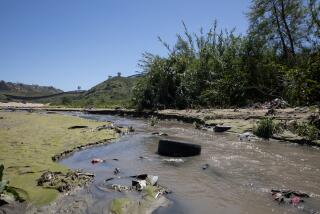New Study to Track Source and Type of Air Pollutants
During the 1950s, meteorologists suspected that not all of San Diego Countyâs dirty air was home-grown. After all, they reasoned, if balloons released by school children in Los Angeles occasionally came back to earth in San Diego, wasnât it likely that air currents also carried pollutants generated by factories and automobiles in Los Angeles?
Technicians subsequently developed complicated monitoring and modeling programs that proved winds were in fact transporting pollution to San Diego from Los Angeles, and county officials now know that out-of-town pollution plays a role in two-thirds of the days when San Diego exceeds state and federal limits for ozone.
Pollution control programs now take âLA transportâ into account, but state and federal regulators also have required the countyâs Air Pollution Control District to create a plan that will reduce the amount of ozone generated within the countyâs border.
To that end, the APCD is conducting a $1.6-million project that uses a boat, balloons and airplanes to monitor pollution within the county. Those mobile monitors have been augmented by a web of land-based monitoring stations in such diverse locations as San Clemente Island, Ramona and Mount Soledad. The airplanes and balloons will grab air samples at various heights, giving officials a three-dimensional look at the countyâs air quality.
The study is designed to determine how much pollution is carried into the county as well as how much is generated within the county. If Mother Nature cooperates--the wrong wind currents can make monitoring difficult--the complex monitoring system will give an accurate picture of where pollution is generated and where winds carry it. The monitors also will help to determine what chemical reactions are occurring once pollution is in the air.
Focus on Hydrocarbons
The monitoring network will pay special attention to hydrocarbons and nitrogen oxide, which are emitted by industrial sources and motor vehicles. Those pollutants are known to react together to form ozone.
While the county easily could order overall reductions in hydrocarbons and oxides, it is âcriticalâ that the pollution control plan include a combination of reductions that will generate a reduction in ozone, said Richard H. Smith, APCDâs deputy director.
âItâs a complicated process because simply decreasing hydrocarbons and nitrogen oxide wonât necessarily bring a resulting decrease in ozone,â Smith said. âYou have to determine the effects of reducing both by varying amounts.â
The APCD will use a computer model to determine the most effective way to reduce ozone. The model will track ozone as hydrocarbons and nitrogen oxide are decreased. Technicians will check the validity of the model against data gathered through the ongoing monitoring program.
No Study for 14 Years
It has been 14 years since the last comprehensive monitoring program was conducted, according to Virginia Bigler Engler, a meteorologist with the Air Pollution Control District. The county is using federal block grant funds to complete the study, which will be used to determine what pollution controls would be necessary if oil drilling rigs were to be located off the coast of San Diego.
The air monitoring program is scheduled to be completed by Sept. 30, but the final deadline might be extended if desired wind currents fail to materialize. That was the case in Sacramento, recently, when the monitoring program was put on hold after wind patterns blowing through the region kept the air unusually clean.
The monitoring program is designed to collect data âwhen there is definitely no influence from Los Angeles as well as when there is,â according to Hal W. Brown, a senior meteorologist with APCD. With that data in hand, âyou can then replicate the model and feel more comfortableâ with the resulting ozone control strategy, Brown said.
If everything goes right with the monitoring study âweâll know whatâs coming into the county and whatâs going on inside the county,â Brown said.
More to Read
Sign up for Essential California
The most important California stories and recommendations in your inbox every morning.
You may occasionally receive promotional content from the Los Angeles Times.










